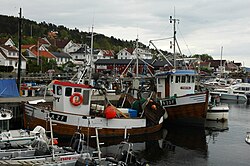Drøbak
Drøbak | |
|---|---|
Unincorporated city | |
 Drøbak from harbor area | |
| Country | Norway |
| County | Akershus |
| District | Follo |
| Municipality | Frogn |
| City status (regained) | 13 February 2006 |
| Government | |
| Population (2006) | |
| • Total | 11,514 |
| • Density | 1,688/km2 (4,370/sq mi) |
| Time zone | UTC+1 (CET) |
| • Summer (DST) | UTC+2 (CEST) |
Drøbak is an unincorporated city and the centre of the municipality of Frogn, in Akershus county, Norway. The city is located along the Oslofjord, and has 13,358 inhabitants.
Drøbak was established as a municipality January 1, 1838 (see formannskapsdistrikt). It was merged with Frogn January 1, 1962.
Traditionally, Drøbak was the winter harbour of Norway's capital, Oslo, since in severe winters the fjord will freeze from outside Drøbak all the way up to Oslo. It had a city status between 1842 and 1962, upon which point the municipality was merged into the rural municipality Frogn and lost its city status. The city status was regained by the municipality council on 13 February 2006. It was also decided that adjacent villages such as Heer would be included within the city.
A notable event in Drøbak's history is the World War II sinking of the German cruiser Blücher in the Drøbak narrows, on the early morning of 9 April 1940. The cruiser was transporting German soldiers and bureaucrats for the planned swift occupation of Oslo, but the sinking by the Oscarsborg fortress delayed this, and thus allowed for the evacuation of the Norwegian Royal Family, parliament, and cabinet, and for the nation's gold reserves to be denied the occupiers.
Early Drøbak had ferries that crossed the fjord, in modern times they have largely been replaced by an underwater tunnel. However, some of the old ferries are still used as "floating restaurants" during the summer.
In summertime, cruise ships visit Oslo almost every day. Often, as many as four or five cruise ships visit each day, in addition to all the regular traffic, it has made Drøbak a popular sea-side tourist spot. However, the numerous restaurants, art galleries and mild summers is probably more important factors for visiting tourists.
Drøbak is also known for its many art galleries. The town has Christmas shop called Julehuset (the Christmas house), and letters often end up in Drøbak from Europe similarly to how they end up in Santa Claus, Indiana in the United States.
Also, Norsk Luftambulanse is headquartered in Drøbak.
The name
The Norse form of the name was Drjúgbakki. The first element is drjúgr 'hard; long', the last element is bakki m '(up)hill'. This is related to the very steep hills upon which main road into Drøbak Center winds.
Places
In Drøbak there are seven notable areas into which the city is divided. These places include:
- Gyltåsen, which mainly consists of cabins and "season-housing".
- Husvik, where most of the year-around boats are being kept. This area was also significant in the sinking of Blücher as the cannons called "Husvik batteri" (The Husvik artillery) lie in the hills of Husvik. The cannons are still in place on these hills for tourist attractions.
- Sentrum (city centre), here lies "Julehuset" and most of the local stores. Most of the City Centre is being protected by local laws as "Verneverdig" which in short terms means that it has a significant cultural value and cannot be changed or rebuilt. Therefore much of the city centre looks like it did 100 years ago.
- Skiphelle and Elleflaten, an area consisting of suburban housing and a tiny hotel called "Drøbak Fjordhotel".
- Sogsti, consisting of much of Drøbak's suburban housing. Also the home of Daniel Eggnog Johansen, and the Indian princess Ramanjit
- Odalen and Haveråsen is the "outer banks" of Drøbak, where the housing and population consists more of agricultural purpose.
- Belsjø and Heer, the suburban housing around the large golf couse surrounding most of northern Drøbak.
- Ullerud and Dyrløkke, a large hill of suburban housing. Here are also the local mall, fire station and a large school up to high school level.
